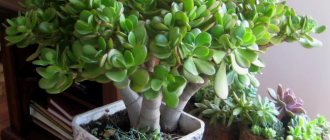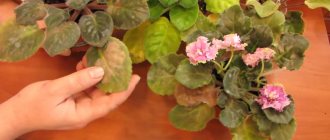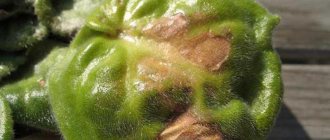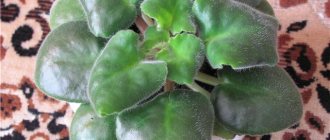Known in Europe since the end of the 19th century, violet in Russia began to gain popularity in the middle of the last century.
Clusters of delicate flowers of various colors, shaded by a dense necklace of lush greenery , attracted the general attention of domestic flower growers.
The plants turned out to be unpretentious in indoor culture , which contributed to the rapid increase in the number of their connoisseurs. One of the main tasks when growing violets is the creation of their decorative outline , and this completely depends on the correct formation of the flower rosette.
General provisions
The health and decorativeness of Saintpaulia specimens growing in home collections are directly dependent on the correct arrangement of leaves in their rosettes.
First, let’s define what a violet rosette is. In a general sense, it is a compact hemisphere with a mosaic arrangement of leaves and inflorescences on top. The rosette is formed as a result of a tiered increase in the length of leaf petioles: the closer to the ground, the longer they are.
This distribution of leaf plates in space helps them not to create a shadow for each other and receive the same amount of sunlight.
Features of watering young plants
When growing violets, beginning flower growers should consider not only the watering regime for young plants, but also how to carry out this procedure. The violet needs to be watered regularly, but not too much.
ATTENTION! Saintpaulia is one of the plants for which a slight drying out of the substrate is not as scary as the accumulation of excess moisture in the pot.
Young specimens exposed to excessive moisture are not able to form a beautiful rosette - from excess water their root system can rot , which will directly affect the condition of the leaf part. It is even possible that the entire bush will die.
The method of watering can also affect the formation of a correct and strong rosette.
Using a watering can
The method of watering with a watering can has its own nuances. Under no circumstances should water be allowed to get on the sheet plates, and especially not in the center of the outlet . This will lead to rotting or deformation of the plant.
If water does get into the outlet, it should be dried using paper napkins.
It is ideal to water along the inner walls of the flowerpot . It is important to control the volume of irrigation water that gets into the pot.
Immersion method
When watering by immersion, it is necessary to monitor the drainage of excess water so as not to provoke the formation of rot.
You should also pay attention to the formation of a salt crust, which can appear on the substrate and negatively affect the development of leaves (leaf blades and petioles are deformed upon contact with excess salt on the soil). Occasionally it is worth watering the flower from above onto the ground to wash off this crust.
But there is also a positive side to this method - it creates a much larger rosette.
Wick method
The method using a wick is suitable for watering violets and provides a constant and necessary supply of moisture , which means a rosette of leaves will form quickly enough without slowing down its growth. But you should also occasionally dry the soil to prevent rotting of the roots.
The negative side is the possibility of cold water getting into the pot in winter , which will cause hypothermia of the plant and affect the growth of the rosette.
Wick watering.
Through the pallet
Watering through a tray has the same negative and positive aspects as the immersion and wick methods. With care and precision, it can be successfully used for young plants , helping to develop the correct contour of the rosette.
Effect of acidified soil
Saintpaulias, with the exception of some species, require a substrate with a slightly acidic reaction for their comfortable growth and proper development of the rosette. A change in soil acidity in any direction invariably leads to a deterioration in the appearance of the rosette and the entire plant as a whole.
An indispensable sign of acidification of the substrate is the formation of rosettes with a thickened center - the leaf blades curl, become hard in appearance and become very compacted during the formation of the rosette due to shortening of the petioles.
Acidic soil does not allow the young plant to absorb sufficient nutrients.
Gradually, this leads to starvation of the violet, a decrease in its vital activity, cessation of growth and loss of the decorative appearance of the rosette.
The optimal way to solve the problem of acidified soil is to regularly replant Saintpaulia in a fresh substrate.
Leaves turn yellow and dry out
It is a pity if large violet leaves begin to dry out, especially when they should not do so. But this is exactly the problem that flower growers face most often!
— Violet leaves turn yellow and wither if the conditions are not suitable for it, because each variety has its own characteristics;
— Leaves may turn yellow if they are constantly exposed to water when watering;
— Ring yellow spots appear in winter when the flowerpot is in a draft;
— The plant turns yellow, becomes stunted and lethargic due to root rot. Then urgent drying and replanting with fungicide treatment is needed;
— Wide yellow trails on the leaves are left by thrips when they eat away the pulp.
How to form a rosette in violets
Young Saintpaulias independently form the contour of the leaf rosette that is optimal for them . The task of flower growers involved in breeding violets is only to minimize the impact of harmful factors on the development of the plant and create a comfortable environment for the proper growth of the rosette.
Next, we will look at how to form a beautiful rosette for an indoor violet.
The nuances of planting in the ground
The first stage in the process of modeling a harmoniously developed rosette can be considered the correct planting of the violet in the substrate . In this process, all the little things should be taken into account:
- the soil for young specimens should be sufficiently nutritious, slightly acidic, with good aeration and water permeability;
- The ideal vessel for a new violet would be a low but wide pot - you should adhere to the calculation that its depth should be approximately equal to the width, and the diameter cannot exceed the size of the plant itself (more correctly, if it is a third of the diameter of the rosette). In a large pot, the violet will grow, but it will not have enough strength to bloom;
ADVICE! You should not choose a large pot for violets: the larger the pot, the greater the likelihood of rapid rotting of the roots, since the moisture will not be able to evaporate longer, and water stagnation will occur. The material from which the flowerpot is made does not play a significant role.
- before planting violets, you need to arrange a good drainage layer and, if necessary, a wick for watering;
When planting violets, be sure to use drainage.
- During the planting process, the violet trunk must certainly be covered with a substrate - an important condition for the formation of a beautiful rosette.
Ways to prevent deformation of young leaves
When forming a violet rosette, even minor violations in care regimes can lead to deformation of the plant’s leaf plates:
- too much watering , as well as water getting on the leaves or in the center of the rosette, changes the contour of the leaves and can lead to their death. You need to adjust the watering and be extremely careful during this procedure;
- an open trunk provokes improper development of the rosette and deformation of the leaves. It is absolutely necessary to sprinkle the trunk when planting;
- a change in the decorative shape of the leaves is possible when the leaf plates come into contact with mineral salts on the surface of the substrate . It is necessary to wash out salts by overhead watering;
- acidic soil contributes to shortening of the petioles, deformation of the leaves and the rosette itself. Optimal soil acidity should be maintained;
- Incorrect lighting or inappropriate temperature indicators lead to loss of decorativeness of leaves . Correction of care regimens is necessary;
- Some diseases and pests spoil the beauty and vitality of violet leaves. The cause should be clarified and treated with chemicals.
Influence of stepchildren
Even at the very beginning of the growth of a young violet, stepsons (or lateral rosettes) can sprout from the axils of its leaves. In some Saintpaulia varieties, the formation of a significant number of stepsons is a genetic feature.
Lateral rosettes do not bring any benefit to violets . A large number of stepsons on the mother plant spoils the decorative appearance of the rosette - it takes on a sloppy, shaggy outline.
Living off the main plant, the stepsons deprive the violet of essential nutrients , and this affects the speed of leaf growth and the correct development of the rosette.
Violet's stepson.
If the presence of stepsons is not due to the characteristics of the variety (trailer and fantasy forms or chimeras), you need to make sure that it is the stepson (not the peduncle) that has formed and remove it. If necessary, for propagation, you can grow the stepson a little, then separate it and put it for rooting.
The role of lighting
For proper development, Saintpaulia needs a lot of diffused light. But at the same time, the violet’s reaction to lighting is twofold: it reacts negatively to any change in it, either towards increasing or decreasing.
If the violet is exposed to uniform, diffused light for a long time, it will form a beautiful outline of its rosette quite quickly.
ADVICE! To ensure that the Saintpaulia rosette is equally shaped on all sides and has a smooth, defect-free outline, experienced gardeners advise constantly turning the pot with the plant relative to the sun's rays.
Bright light (especially in summer) can slow down the formation of a harmonious rosette, and direct rays of the sun can burn the leaf blades, leaving ugly spots on them.
To protect itself from dangerous brightness, the violet tries to remove the leaves from the light by bending them closer to the flowerpot. In addition, the color of the leaf plates does not change for the better. Therefore, shading is required.
A small amount of light causes the opposite effects:
- leaf petioles become long;
- leaves stretch;
- the violet bristles with raised leaf blades.
To prevent this from happening, you should consider a lighting system .
Both reactions to lighting affect the development of the rosette, disrupting its beautiful appearance.
Peduncles: to remove or not?
A young plant spends considerable energy on forming its contour. it is advisable to remove all flower stalks that form during this period - otherwise the developing plant will not have enough strength for two processes and it may die.
If you remove the flowers in the early stages of violet development, then the mature plant will bloom more luxuriantly.
After breaking off the peduncles, the violet may begin to grow stepsons, but they should also be immediately eliminated before the bush has finally taken shape.
Physiological balance: leaf crown or flower stalks
Every young Saintpaulia plant that begins to develop in indoor culture tends to sooner or later achieve a physiological balance between the main parts of its body.
This means that the leaf mass, formed to the required size, is fully supported by the appropriate number of roots . Only under this condition is the violet considered sufficiently grown to enter the next phase - the phase of laying buds and forming flower arrows.
Only a healthy adult violet will begin to form buds.
During the period of searching for balance, the violet, trying to solve the problem as quickly as possible, can actively form stepsons. But upon reaching the goal, the plant switches to flowering. In this case, peduncles and growth points may appear from the leaf sinuses.
To develop a rosette of the intended shape, the gardener must regularly pinch off all flower shoots and stepsons , after which the Saintpaulia will be forced to release another row of growth points, on which flower stalks will again be planted. This can continue circle after circle until the desired plant shape appears.
In this matter, the goals of the violet and the florist do not agree, but the person usually turns out to be more persistent and gets the intended contour.
The need for fertilizing
Fertilizing is not mandatory for most Saintpaulia varieties. To carry out this procedure, you should be guided by the appearance of the plant:
- if the leaves are lush and healthy, then there is no need to fertilize;
- If the bush does not develop well enough, you can apply mineral fertilizer.
When the leaf part of the violet is well developed, but flowering does not occur, phosphorus and potassium preparations can be used . will contribute to the formation of strong green mass .
CAREFULLY! When feeding, it is necessary to carefully calculate the dose of fertilizer - it should be half of that recommended on the package. Otherwise, unexpected problems may occur.
But all these recommendations do not work for Saintpaulias with rich leaf mass. For specimens of such varieties, regular food cannot be sufficient due to the high energy consumption to maintain the beauty of the outlet.
In these cases, fertilizing is simply vital: it is carried out according to all the rules of agricultural technology, but also in reduced doses.
What is a corset, how to make it and what is it for?
The goal of flower growers who grow Saintpaulias is to obtain an even and lush rosette. To accomplish this task, a corset was invented - a special device made from a disposable plate , put on the violet from below and supporting the leaves in the desired position.
The corset can be used only after the formation of the first tier of strong leaf plates . The moment for trying on the corset should be chosen after the soil has lightly dried - at this time the leaves are more pliable and less susceptible to damage.
Corset for violet.
With the help of various corsets, flower growers have learned to form convex and concave contours of leaf rosettes.
Why does the socket thicken?
Sometimes Saintpaulias develop a very dense central part. Here are a number of reasons why the center of a violet’s rosette thickens:
- the size of the flowerpot is much larger than the diameter of the violet;
- violets were often fertilized with nitrogen - overfeeding;
- change in the acidity of the substrate, which means starvation of the plant;
- defensive reaction to bright or insufficient lighting;
- root rotting due to errors in irrigation regimes;
- low indoor humidity;
- pests and diseases of violets lead to the same effect.
Rejuvenation methods
Violets are perennial plants that, with proper care, can live in the collection for a long time.
But gradually the lower part of the trunk becomes bare due to the removal of old leaf plates, the plant ages and loses its decorative effect.
Rejuvenation of sockets , can help in this case :
- Saintpaulias with a bare, but not very elongated stem are simply topped with substrate so that new roots can form;
- Experienced flower growers advise replanting a violet with a bare, long, but still green stem into a more suitable pot with fresh substrate. The replanting process must necessarily include deepening the stem to the level of the leaf blades and shortening the root system;
- updating an old rosette when the lower part of the stem has changed color, has become rough and cannot grow roots consists of: clearing the violet of most of the leaves (it will require a lot of effort to restore);
- cutting the upper part of the rosette along the border on the stem between the green and brown areas;
- placing this piece of plant in a glass of water. In a couple of weeks, roots should appear.
How to properly divide overgrown specimens?
Rosette division is used as the easiest and most effective way to propagate violets. Used in case of multiple formation of stepsons on maternal Saintpaulia.
Overgrown rosette of violet.
So, how to separate sockets:
- the entire specimen is removed from the flowerpot;
- carefully divided into parts using sharp and disinfected instruments;
- sections are treated with charcoal;
- It is important that each stepson has already acquired its own root system. Then they are simply carefully planted in new pots;
- how to root a violet rosette without roots? In this case, the roots are first grown in water, and then the stepsons are planted in pots.
CAREFULLY! When dividing a violet, you cannot clear the roots from the soil - the flower reacts very painfully to all manipulations.
Emerging problems
Most problems with indoor Saintpaulia cultivation arise from errors in plant maintenance:
- Rotting of the center of the rosette occurs due to too much watering, accompanied by sudden changes in temperature. Adjust maintenance regimes;
- The violet does not develop a rosette - it may be damaged by pests. If parasites are detected, the plant should be quarantined and treated with insecticides. If pests are not visible, the conditions of detention should be reconsidered;
- The socket is wobbly - if there are problems with the root system (lack of roots on the lower part of the stem) arising due to watering errors. Change care regimes, sprinkle the lower part of the stem with substrate and place in a greenhouse;
- The central leaves turn yellow - due to violations of watering regimes, low humidity or too bright lighting; The central part turns black - with cold watering. Correct deficiencies in care.
Fertilizers
The violet pleases with its flowering almost all year round, taking a break only in July-August. To prevent the plant from becoming depleted, it must be periodically fed with organic and mineral fertilizers. We use fertilizing approximately once a month, but do not overload it during the hot period.
There are compositions special for violets with a high content of potassium, phosphorus and nitrogen. It is these elements that influence the full growth and abundant flowering of violets. It is best to choose liquid solutions and apply them on top.
Corrective Action
Now we have figured out the main reasons for leaf curling, now we just need to learn how to eliminate them.
Eliminating the consequences of the flood
The first thing to do when a flood occurs is to carefully transfer the violet to another pot with drier soil. In this case, it is necessary to cut out all rotten places on the root system. If the symptoms of flooding have just begun to develop, you can get by by drying the earthen clod and loosening it.
You should also check for drainage holes. To prevent flooding in the future, you need to follow these simple rules:
- Water only after the top layer of soil has dried out.
- Watering is best done from a tray
- After watering, be sure to drain excess water from the tray.
Fighting ticks
The cyclamen mite is a rather dangerous and difficult to remove pest. Its destruction must be approached comprehensively. The first thing to do is isolate the infected plant. It should be noted right away that it will most likely not be possible to save a very heavily infected violet.
The next thing to do is to remove all severely damaged leaves on the plant. After this, treatment with special acaricide preparations begins. For example, in indoor conditions you can use Fitoverm. There is no point in using traditional insecticides against ticks; they will be ineffective in combating them.
Video on how to fix problems with violets:
Restoring the lighting and fertilizer regime
For successful development, violets require soft, diffused lighting. If this condition is violated, its leaves begin to deform. When keeping plants under lamps, the duration of daylight hours should not exceed 12 hours. And the lamps themselves should be located above the plants at a height of 25-30 cm.
The fastest way to eliminate overfeeding is to transfer it to fresh soil. To prevent this from happening in the future, it is best to purchase a special substrate for growing violets.
When applying fertilizers, you should strictly observe the required dosage and frequency of use. When using universal mineral fertilizers for feeding, it is recommended to reduce their dosage by half.
We help the plant adapt after transplantation
If the transplant went wrong, the plant needs help to adapt to the new location. To do this, immediately after transplanting, the pot is placed in a dimly lit place for several days. Also, for easier adaptation, a greenhouse effect can be created for the plant. To do this, you can cover it on top with a plastic bag. Various immunostimulants have a good effect.
For example, you can use Epin or Zircon. To prevent leaves from curling in the future, you must strictly follow all necessary care measures, select the correct watering and lighting conditions, and also periodically inspect the plant for pests.
vote
Article rating
What diseases threaten the plant?
The result of neglecting the basic rules of care is painful conditions of Saintpaulia and the appearance of pests. By analyzing changes in the state of violets, you can “make a diagnosis” and make adjustments to your actions:
- Brown formations appeared on the leaves of the rosette. For irrigation it is worth taking warmer water.
- Some parts of the plant have turned light yellow. The changes were provoked by direct sunlight.
- All leaves gradually turn yellow. This is a signal about dry air or errors in watering or too much fertilizer.
- The middle of the inflorescence rots. Such a catastrophe is caused by sudden changes in temperature and an abundance of liquid.
- The cuttings are too tall. Temperature too low: the plant is too cold.
All the situations mentioned “prevent” the violet from blooming. When pests appear, they need to be dealt with. Soil disinfection and systemic fungicides will get rid of insects.
- Mealybug
- Mite
- Whitefly
- Thrips
- Powdery mildew
- Vascular bacteriosis
A very dangerous case is rotting of the root collar. With this disease, the leaves become limp and lifeless. It is almost impossible to cure the plant. At the same time, the violet can infect other flowers: it should be isolated.
You can still try to save Saintpaulia. It is dug out and all affected areas are separated. Disinfect the pot with laundry soap and plant it again.
If almost the entire plant is affected, then the only way out is to cut off the healthy leaves and re-grow the violet.
Mold on the leaves signals pests. In this case, spraying with water is prohibited. Saintpaulia will come back to life again after treatment with special means. Diseased leaves are removed. Violet is a gentle creature that reacts sensitively to any mistakes in care.











